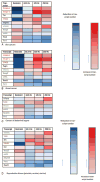Transcriptional Pathways Altered in Response to Vibration in a Model of Hand-Arm Vibration Syndrome
- PMID: 27058473
- PMCID: PMC4837947
- DOI: 10.1097/JOM.0000000000000705
Transcriptional Pathways Altered in Response to Vibration in a Model of Hand-Arm Vibration Syndrome
Abstract
Objective: The aim of this study was to use an established model of vibration-induced injury to assess frequency-dependent changes in transcript expression in skin, artery, and nerve tissues.
Methods: Transcript expression in tissues from control and vibration-exposed rats (4 h/day for 10 days at 62.5, 125, or 250 Hz; 49 m/s, rms) was measured. Transcripts affected by vibration were used in bioinformatics analyses to identify molecular- and disease-related pathways associated with exposure to vibration.
Results: Analyses revealed that cancer-related pathways showed frequency-dependent changes in activation or inhibition. Most notably, the breast-related cancer-1 pathway was affected. Other pathways associated with breast cancer type 1 susceptibility protein related signaling, or associated with cancer and cell cycle/cell survivability were also affected.
Conclusion: Occupational exposure to vibration may result in DNA damage and alterations in cell signaling pathways that have significant effects on cellular division.
Conflict of interest statement
There are no conflicts of interest, or additional funding sources to declare.
Figures





References
-
- Griffin MJ. Handbook of Human Vibration. London: Academic Press; 1990.
-
- Stoyneva A, Lyapina M, Tzvetkov D, Vodenicharov E. Current pathophysiological views on vibration-induced Raynaud’s phenomenon. Cardiovasc Res. 2003;57:615–624. - PubMed
-
- Bovenzi M, Fiorito A, Volpe C. Bone and joint disorders in the upper extremities of chipping and grinding operators. Int Arch Occup Environ Health. 1987;59:189–198. - PubMed
-
- Necking LE, Lundborg G, Friden J. Hand muscle weakness in long-term vibration exposure. J Hand Surg Br. 2002;27:520–525. - PubMed
-
- Necking LE, Friden J, Lundborg G. Reduced muscle strength in abduction of the index finger: an important clinical sign in hand-arm vibration syndrome. Scand J Plast Reconstr Surg Hand Surg. 2003;37:365–370. - PubMed
Publication types
MeSH terms
Substances
Grants and funding
LinkOut - more resources
Full Text Sources
Other Literature Sources

